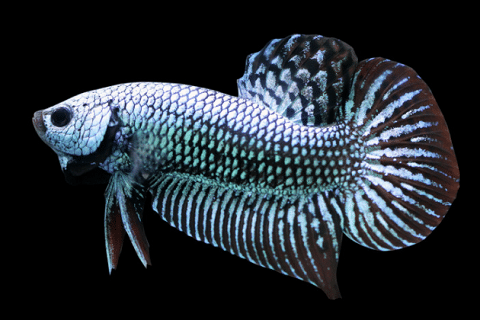Thank you for visiting! By the way… any links on this page that lead to products on Amazon and other stores/partners are affiliate links Aquarium Store Depot earns a commission if you make a purchase.
The Siamese fighting fish (Betta splendens) is one of the most interesting tropical fish in the aquarium hobby. Many experienced fish keepers started out with just a single male betta fish, and you can walk into pretty much any pet store and find a selection of these wonderful fish.
Surprisingly, females are much rarer, and many people have never even seen one! But why are female betta fish rare, and how are they different from the males? Read along to find out!
Key Takeaways
- Female bettas usually have smaller fins and less color than male bettas
- Most bettas in pet stores are male
- Female bettas are less aggressive than males, but they will still fight with each other
- It is possible to keep female bettas together, but male bettas should be kept on their own
Male Vs Female Betta Appearance
Male and female bettas can look very similar unless you know exactly what to look for. Let’s say you just walked into the pet store and you want to pick out a single female betta fish. How would you know which is which? The best approach is to look at a combination of small differences.
Ready to learn? Let’s get started!

Size and Body Shape
Male bettas are slightly longer and leaner than females. The length difference usually only comes down to about a quarter inch or so, but the body width can be pretty noticeable. Females are wider across the back and belly, which is especially noticeable when viewed from above.
Fins
Bettas are loved for their amazing long fins. There are loads of different betta breeds, and some look very different from others. Elephant ear bettas are just bursting with fins, while plakat betta fish have relatively small, and compact fins.
So how do you tell female and male betta fish apart by their fins? Male betta fish generally have larger fins and females have shorter fins. The difference is pretty clear in most betta breeds, but in smaller-finned varieties, the ventral fin is the best place to look.
Let’s take a look at the various betta fish fins and how they differ:
- Pelvic/Ventral fin
The ventral fins are the paired fins that hang down below the body, just behind the gills. Male betta fish have much larger and longer ventral fins.
- Anal Fins
The anal fin is the long flowing fin that extends from behind the ventral fin all the way to the tail. This is the largest fin on some betta fish breeds. Male betta fish have much longer anal fins than females, and this can be a good clue for telling them apart.
- Caudal fin (tail)
Male betta fish have longer tails than females. The size difference is very obvious in some breeds like the rose tails, but not very clear with plakat betta fish.
Color
Male betta fish are usually more colorful than females. Females tend to have more gray and silver colors, but sometimes they can be even more colorful than male bettas.
Egg Spot
Female bettas have an egg spot between their ventral and anal fins. This small bump is the ovipositor tube where the eggs are released. The egg spot is another useful clue for telling male and female betta fish apart.
Gill Plate Cover
Betta fish can flare out their gill plate covers (operculum). Both male and female betta fish do this to show dominance and aggression, but the male fish tend to flare more often.
The larger gill plate cover of male betta fish looks kind of like a beard, so that’s a good way to remember this difference.
Behavior
Male and female betta fish can look a lot alike, but some unique behaviors really help set them apart.
Here’s what to look for:
Bubble Nests
Bettas are from the Osphronemidae family, a group of fish that build bubble nests where the eggs develop in a more oxygen-rich environment. Males create bubble nests, and they will do this even if they are kept alone in their own tanks.

Bubble nests are basically small rafts of bubbles that float together at the water’s surface. The size of the bubble nest varies, and it can often be found in the corner of an aquarium, especially after a water change. Female betta fish can also make bubble nests but this is pretty rare.
Temperament
Captive-bred betta fish tend to be far more aggressive than the wild fish they were bred from. There are many types of wild bettas, however, so it really depends on the species.
Domesticated Betta splendens are extremely popular in the fish-keeping hobby today but they were originally bred for sport. That’s right, bettas were bred to fight, and generations of winners have produced a pretty mean breed of fish!
Male bettas tend to be more aggressive than females, but each fish has his or her own personality. The difference in temperament means female betta fish are a little more flexible when it comes to tank mates. Read more about this later in the article.
Care
Male and female betta fish have very similar care needs. There are some slight differences that we’ll get into below, but both sexes need good water quality, enough space, and a healthy diet to live a long, happy life.

Tank Setup
Betta fish need an aquarium of at least 5 gallons. You might buy them in a cup over at the pet store, but they will not live for very long in such cramped conditions. Here’s a basic setup for male or female betta fish:
Those four core components are vital for keeping your fish healthy. You’ll also want to decorate your tank of course, and that’s where some potential differences come into play.
Aquarium Decorations
Betta fish do not need to have substrate in their tank, but you’ll probably want to add a layer of aquarium-safe gravel to the bottom of your aquarium for aesthetic reasons.
Caves and ornaments will add interest to your tank and make it a more natural and stimulating environment for your fish.
Unfortunately, the long, flowing fins of the male betta fish can tear very easily, so you need to be extra careful when choosing decorations. Avoid anything with sharp edges that could cause damage. Females are less vulnerable than male bettas because they have short fins, but it’s still something to think about.
Plastic plants can be especially dangerous for your fish so choose soft, silk plants, or even better, grow the real thing! Aquatic plants are surprisingly easy and fun to grow and care for.
Silk plants that are designed to be gentle on fish with fancy fins like Bettas and Fancy Goldfish
Water Quality
Keeping male or female betta fish healthy in the long run requires good water quality. So how do you make sure your water is safe and healthy for your fish?
Let’s take a look at the basics of betta fish tank maintenance.
The water in your betta fish tank changes over time as fish waste and excess food accumulate. This causes chemical changes in the water due to the nitrogen cycle, and the water becomes more and more toxic for your fish.
The only way to monitor these changes is to test your water regularly and perform partial water changes whenever necessary. Growing some live aquatic plants can certainly improve your water quality, but you’ll still need to roll up your sleeves once, twice, or even four times each month.
Feeding Your Betta Fish
Male and female betta fish can be fed the same diet. You can feed these tropical fish small prepared foods for freshwater aquarium fish or choose from some excellent betta pellets made specifically for your siamese fighting fish. A high-quality diet can bring out the best in your betta fish colors.
Best Betta Food
Fluval bug bites is made of various insect and shrimp ingredients making this a high quality source of protein
Supplementary live and frozen foods like bloodworms make a tasty treat for your Siamese-fighting fish and are a great way to get your fish into good spawning condition if you plan on breeding them.
Tank Mates
The only real downside to betta fish is their aggressive behavior towards other bettas. Most Siamese fighting fish keepers keep just one fish in their own tank.
These beautiful fish can actually get along just fine with many species in a community aquarium, however. But how do you know which other fish will get along with your betta?
Betta fish can be kept with other small tropical fish that enjoy the same water parameters and tank conditions. They should only be kept with peaceful fish, of course, because bettas can be bullied and hurt by other species.
Never keep Siamese fighting fish with fin nippers like tiger barbs, or any aggressive or large and predatory fish.
Read on for some great betta fish community tank mates!
Betta Tank Mates
Female Betta Sororities
Betta fish tend to fight with their own species, which is why it’s always best to keep them on their own. You probably know that male bettas should never be kept with other males. It is possible to keep a female fish with other female betta fish, however, and this is known as a betta sorority.
Betta sororities don’t always work out because female bettas can still be aggressive toward other females. If you do go this route, a 20+ gallon tank size is going to be your safest bet, and you’ll need to carefully monitor your fish and be ready to move them to another tank if you notice any aggression.
Bettas are not very social fish, so there’s nothing wrong with keeping a single female in her own tank.
Keeping Male and Female Bettas Together
Keeping male and female betta fish together in the same tank is a bad idea! These fish can be very aggressive towards their own species and will often hurt each other very badly- or worse.
It is possible to keep two bettas together in the same tank if you have a divider in the aquarium. A tank divider is a physical barrier that keeps the fish apart but allows water to flow between both sides of the tank, making water quality easier to maintain.
Budget Option
A DIYer's option. Divide your aquarium and house multiple Bettas!
A divider that is opaque or partially clear is the best bet because this minimizes flaring and fighting between the fish on either side of the divider. Your bettas will be able to sense each other even with a solid divider in the tank, so using separate tanks is recommended unless you plan on breeding the fish.
Breeding Betta fish
You’re probably wondering how betta fish breed if the males and females are so aggressive toward each other! There is a good video by Aquaplanets that shows the process below.
It is possible to breed betta fish at home, although you need to be quite careful to avoid aggression and fighting. Keeping the pair together in a divided tank is a great way to introduce them safely since they will be able to sense each other’s hormones and prepare to reproduce.
Only healthy, well-conditioned male and female bettas should be bred, and the pair should be moved into a separate, dedicated breeding tank. The female can be kept in a breeder box until the male has built his bubble nest and they are ready to mate.
Once the eggs are laid, the female should be removed from the tank because the male will begin to attack her. He does this because female bettas will eat their own eggs. The male fish can be kept in the breeding tank until all the eggs have hatched and the fry are free swimming.
FAQs
Is a male or female betta better?
Both male and female bettas make wonderful pets, so it’s impossible to choose which is best! Male betta fish usually have a better variety of bright colors and longer fins, however, so they tend to be more popular as display fish.
Can 1 male and 2 female betta fish live together?
You should not attempt to keep male and betta fish together in the same tank. Sure, it does work out now and then, but there’s a good chance that it will end in tragedy because these fish often fight to the death.
Are male or female bettas easier to take care of?
Male and female bettas have the same general care needs, so they are equally easy to care for.
Are female bettas less aggressive than males?
Females tend to be less aggressive than male bettas but this is not always the case. In fact, female bettas often kill males, so both sexes should be treated as aggressive fish.
Can female bettas be kept together?
It is possible to keep females together but this is not advisable for beginner fish keepers. This type of setup is known as a betta sorority and should consist of at least 5 females in a tank size of 20 gallons or more.
Should female bettas be alone?
Female betta fish can be kept alone, and this is the easiest and safest way to care for them. They need a heated and filtered tank of at least 5 gallons to stay healthy in the long run.
Are female bettas aggressive?
Female betta fish can be very aggressive. They tend to be less aggressive than the male bettas but each female betta fish has her own personality of course.
How can you tell if a betta fish is a female?
Female betta fish tend to be smaller and less colorful than their male counterparts. They also have a thicker body, shorter ventral and anal fins, a smaller gill plate cover, and a characteristic egg spot at their vent.
Final Thoughts
Knowing how to tell the sexes apart is really important, especially if you plan on breeding these fish or setting up a sorority tank. Unfortunately, pet stores don’t always keep female betta fish in stock because they aren’t as colorful as the males, but that doesn’t mean they aren’t awesome pets!
After reading this article, you should have no problem in identifying female and male betta fish. Remember though- both male and female betta fish can be very aggressive so beginners should not keep more than one of the same species together.
Male vs female betta fish- Which is your favorite? Let us know in the comments below!
- About the Author
- Latest Posts
I’m thrilled that you found Aquarium Store Depot! Here you’ll find information on fish, aquariums, and all things aquatics related. I’m a hobbyist (being doing this since I was 11) and here to help other hobbyists thrive with their aquariums! I adhere to a high quality Editorial Process and Review products with real life field usage and practical analysis.








